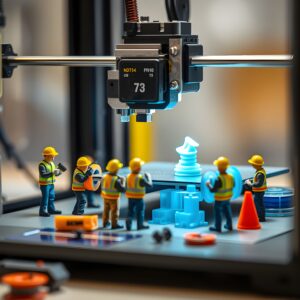3D Printing in Dentistry: Revolutionizing Dental Care

Discover how 3D printing is transforming dental care, from creating custom aligners to innovative implants.
The dental industry is experiencing a significant transformation thanks to the integration of 3D printing technology. This innovative approach is revolutionizing dental care by enabling the rapid and precise production of custom dental appliances, implants, and prosthetics. In August 2024, new advancements in 3D printing technology further solidified its role as a game-changer in dentistry, offering unprecedented benefits for both patients and dental professionals.
Custom Aligners and Crowns
One of the most widespread applications of 3D printing in dentistry is the creation of custom aligners, such as those used in orthodontic treatments. Traditionally, creating aligners and crowns required multiple visits, extensive manual work, and long wait times. However, with 3D printing, dentists can now produce these appliances with greater accuracy and speed. By using digital scans of a patient’s teeth, 3D printers can create aligners and crowns that fit perfectly, improving both comfort and effectiveness. This process not only reduces the time it takes for patients to receive their appliances but also ensures a higher level of customization and precision.
Dental Implants and Prosthetics
Another area where 3D printing is making a significant impact is in the production of dental implants and prosthetics. Dental implants require a precise fit to ensure stability and longevity, and 3D printing allows for the creation of custom implants that match a patient’s unique dental structure. In August 2024, several innovations in biocompatible materials were introduced, enhancing the integration of 3D printed implants with natural bone. Additionally, 3D printing enables the production of highly detailed prosthetics, such as dentures and bridges, that are tailored to the exact measurements of a patient’s mouth, improving both function and aesthetics.
Streamlining the Workflow
The introduction of 3D printing in dental practices has significantly streamlined the workflow, reducing the need for outsourcing and shortening the overall treatment time. Dental labs equipped with 3D printers can now handle most aspects of appliance production in-house, from design to final fabrication. This not only speeds up the process but also reduces costs, making high-quality dental care more accessible to patients. Moreover, the ability to quickly iterate and adjust designs based on patient feedback allows for a more responsive and patient-centered approach to dental care.
Improving Patient Outcomes
The precision and customization offered by 3D printing are leading to better patient outcomes. Custom-fit dental appliances and implants mean that patients experience greater comfort, improved functionality, and faster recovery times. Additionally, the use of high-quality materials and advanced printing techniques ensures that the products are durable and long-lasting, reducing the need for future adjustments or replacements. As a result, patients are benefiting from more effective treatments and a higher quality of care.
The Future of Dentistry
As 3D printing technology continues to evolve, its applications in dentistry are expected to expand even further. Future developments may include the use of advanced materials that mimic the natural properties of tooth enamel and dentin, as well as the ability to print complex structures such as nerve and blood vessel networks within implants. These advancements could open up new possibilities in regenerative dentistry, where damaged or missing tissues are replaced with 3D printed counterparts.
3D printing is revolutionizing dental care by making it more efficient, precise, and patient-focused. The advancements made in August 2024 highlight the ongoing evolution of this technology and its growing importance in the field of dentistry. As more dental professionals adopt 3D printing, patients can look forward to a future where dental care is faster, more personalized, and more effective than ever before.



